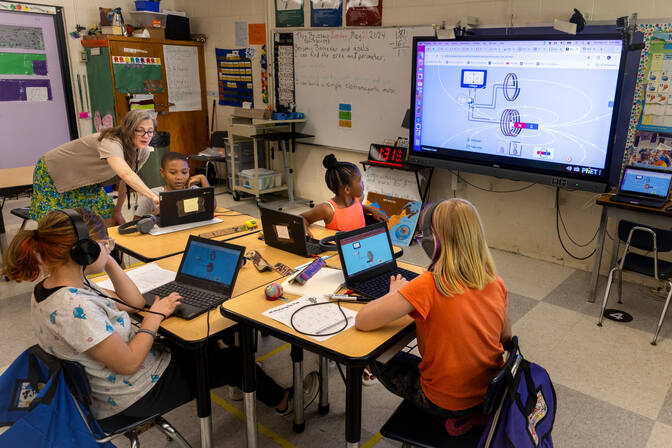
Electric vehicle lessons cruise into Michigan classrooms
New curriculum in U-M professor’s digital education platform introduces K-8 students throughout Michigan to jobs in one of the state’s emerging industries.

New curriculum in U-M professor’s digital education platform introduces K-8 students throughout Michigan to jobs in one of the state’s emerging industries.
Experts

Co-director of the Center for Digital Curricula
Arthur F. Thurnau Professor of Computer Science and Engineering
“I want to be a cop,” says Kytana Riley, a third-grader in Melissa Bruzzano’s class at Holmes Elementary School in Ypsilanti, Mich., last spring. She demonstrates her enthusiasm by pulling out of her backpack a paper-bag puppet of a police officer. Riley had made it in Spanish class, cutting the officer’s uniform out of construction paper and coloring the hair to match her own—light blonde with magenta highlights.
Riley’s classmates want to be doctors, firefighters or build trains. A career involving electric vehicles isn’t on anybody’s radar, likely because it hasn’t been presented as a possibility. Many students in the underserved school district don’t see EVs or engineers every day. But a new curriculum developed by Michigan Engineering’s Center for Digital Curricula with support from the Electric Vehicle Center aims to change that. The curriculum is designed to show K-8 students how they can one day plug into the EV industry, which is slated to bring thousands of jobs to Michigan in the near future.
“We hope to nurture our children’s natural curiosity in electric vehicles and inspire them to help design and build greener technology,” said Elliot Soloway, co-director of the Center for Digital Curricula and Arthur F. Thurnau Professor of computer science and engineering at the University of Michigan.
“It’s what the future is, and the kids, as young as they are, want to see the future,” Soloway said.
Melissa: Everybody, we’re going to have a little five-minute brain break.
Student: One. Two. Three. Don’t worry about a thing, ’cause every little thing is gonna be alright.
Elliot: Democracy needs education. Public education is the cornerstone of democracy. And if we want to live free, people have to be educated and able to make decisions.
Narrator: To help educate the digital-first generation, a computer science professor at the University of Michigan developed a tool called Roadmaps.
Elliot: I want to see Roadmaps take off, and we’re on the cusp of it.
Narrator: Roadmaps relies heavily on technology and computers in classrooms. Homes Elementary in Ypsilanti is one of the schools testing the platform.
Elliot: The term these days is Alpha Generation—children born after 2012. These are the kids who grew up digital-first. They grew up with phones, for better or for worse. Yes, they are screen-oriented, so we have to use the technology and tools they are expecting in the classroom.
King: Yeah, of course, it’s really, really fun and nice because it’s like a fun way of learning. You know, if I get the chance to do anything creative, I’ve got to do it.
Melissa: In general, they’re going to understand or retain it more if it’s in a video format or a hands-on thing, so I really like using it that way.
Narrator: Recently, Soloway updated Roadmaps with a curriculum that introduces students to electric vehicle technology.
Elliot: Technology is about new. Technology is about change. Change is hard, especially in the classroom. What we need to do in the curriculum is include pieces of the world that are new and different. Electric vehicles are new. They’re different. They’re part of the next world.
Melissa: You’ll know your magnet is inside another magnet’s magnetic field when you feel a push or a pull, right? Sometimes when you put the opposite ends together, right? I do like to pull science into my classes, so that’s why I’m doing this Electric Vehicles Roadmaps, because it does seem to be kind of perfect for my kids, and they’re enjoying it.
King: Yeah. We mainly focus on how everything works in these cars and electricity.
Elliot: How does a battery work? Batteries are central to electric vehicles and electrification in America. How does a battery work? Where does the material that goes into a battery come from? Let them learn about that. Fortunately, we’ve partnered with the Michigan Economic Development Corporation. We’re developing an electric vehicle curriculum. The teachers like it, the kids like it. It’s new. It’s what the future is.
Melissa: The directions are always going to be up at the top.
Elliot: And the kids, young as they are, want to see the future.
Students: All right. So if you get up and look, you’re like, “Well, no, I can do that.” No, no, it’s a challenge, and you know, it’s called “Down the Ladder.” Oh, right.
Michigan’s automotive landscape is already transitioning to electric power. The number of EVs registered in Michigan rose to around 33,000 in 2022—89% higher than the previous year. More are on the way, as the state is shaping up to be a focal point for the shift from gas-powered to hybrid and fully electric vehicles, as previously reported in the Michigan Engineer. Over the last eight years, EV manufacturers have announced plans to invest $20.4 billion into the state’s EV and battery manufacturing sector, according to a 2024 report from the Environmental Defense Fund. So far, Georgia is the only state with more announced investments.
Those investments could create over 18,000 jobs directly related to EV design and manufacturing in Michigan. Over 100,000 additional jobs will be needed to install charging infrastructure across the country, and the total number of indirect and secondary positions created nationally could be as high as 876,000, the International Council on Clean Transportation and EDF report.
“We are in a time where we need to start investing in young people so that they can understand what these emerging career paths might look like,” said Spencer Lucker, director of strategic talent initiatives at the Michigan Economic Development Corporation. These programs aim to expose Michigan’s future talent to the state’s strategic industries and Michigan employers’ priority occupations and provide experiential learning opportunities. The organization provided $500,000 in 2023 to support the development and testing of the new digital EV curricula.
To fill those jobs, Michigan will need people with the right skills and interests. The ten EV and mobility units included in the Center for Digital Curricula’s Roadmaps platform teach K-8 students about Michigan’s changing automotive industry and the kinds of professions that work with EVs, in addition to the fundamentals of battery technology and electricity.
“The Roadmaps platform creates a tremendous opportunity not only for students to learn new skills but also for us to expose them to age appropriate information about career pathways and employers that will likely influence their future career choices,” said Ashlee Breitner, workforce director for the U-M Electric Vehicle Center.

The curriculum developers hope to plant a seed from which student’s interest in sustainable technology will grow.
“By connecting their natural curiosity with real-world applications in the electric vehicle industry, it empowers students to envision and shape a future driven by innovation and sustainability,” she said.
“This curriculum is perfectly tailored for the Alpha generation, as it integrates hands-on, interactive learning experiences that resonate with their digital-native instincts,” said Anne Tapp Jaksa, director of professional development for the Center for Digital Curricula and a professor of teacher education at the Saginaw Valley State University.
Bruzzano was one of ten Michigan teachers to beta-test the new EV curriculum during the 2023-2024 school year. They are the latest recruits to the growing community of teachers using the Roadmaps platform, which aims to become a central hub for K-8 teachers to access free, standards-aligned curricula for core subjects and electives. The platform is now used by 250 teachers across 25 school districts for a variety of subjects, and its teacher retention rate is around 99%.
Bruzzano’s passion for protecting the environment motivated her to test the EV curriculum. She saw it as a way to show students one solution to greenhouse gas pollution.
“The younger that the kids are when they learn this kind of stuff, the more it becomes a part of society,” Bruzzano said. “Going forward, I think education in this area is going to be really important because it will help students have a better understanding of some of the challenges that society faces.”
Other teachers tested the curricula to expose their students to the hands-on lessons.
“I got excited about it because of stuff like interactive online labs that I knew the kids would really like, and that you could do everything pretty much in one platform,” said Laura Trombley, who tested it in her third-grade computer science class at R.B. Havens Elementary in Saginaw, Mich.
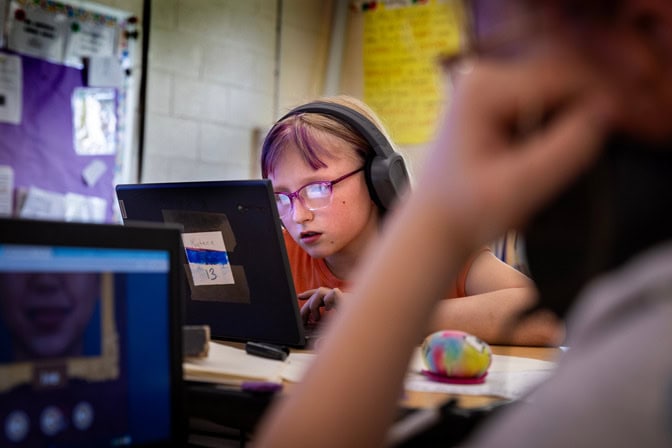
The prototype EV lessons were a hit among the students. Riley, the aspiring police officer, jumped out of her chair and clapped her hands when it was time to start up the most popular part of the lesson—an interactive electricity lab from an open educational resource project at the University of Colorado Boulder called PhET Interactive Simulations.
She opened the program and was taken to a blue workspace. A toolbar offered buttons she could choose from to make a circuit—digital wires, lightbulbs, batteries and more. Riley clicked and dragged a picture of a battery into the blue workspace. Next was a wire. She placed one end of the digital wire on the battery. After adjusting the wire’s length a bit, she dragged a lightbulb over to the open end of the wire. When she closed the circuit with another wire, the bulb lit up.
The light rays were a little small and thin for her liking, so she switched to a battery with more voltage. The rays became longer and thicker.
Two desks away, her classmate, King Robinson, starts the lab with a bit more ambition. He drags five high-voltage batteries onto the virtual workbench, then connects them to the lightbulb. King discovered that the voltage was too high after the batteries burst into cartoon flames when he connected them to the lightbulb.
“I’ve made a doomsday device,” he said, giggling. Removing a few batteries and adding a resistor averted the virtual apocalypse.
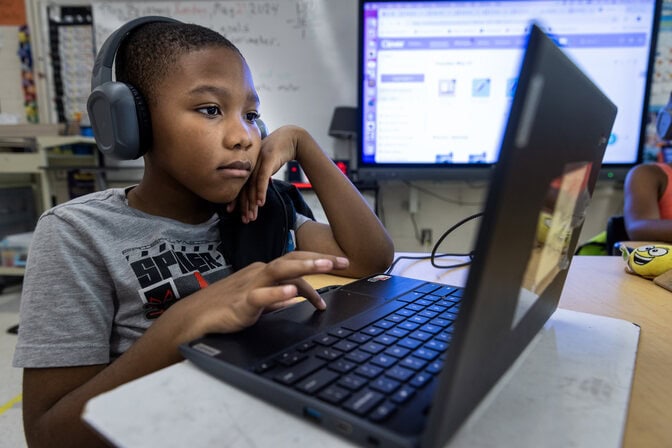
“It was cool for them to learn by doing,” said Bruzzano. “Instead of just being kind of this rote thing, it was very informative and very interactive, and I think they felt like they were learning something cool and new.”
Bruzzano has since left her job at Holmes Elementary to pursue a career in environmental science, but other teachers share her opinion. In their end-of-year survey, the ten teachers who tested the curricula rated it 4.5/5 for student engagement and 4/5 for age appropriateness, on average.
The students “were really engaged because they could manipulate the parts, and they had to completely figure it out themselves,” said Trombley. “I find just letting kids figure things out is best, especially in science concepts. You can’t just set them loose with batteries and wires, but in the simulation inside Roadmaps you can get close.”
The sentiment that digital lessons help students is rare among teachers in the post-COVID era, according to surveys from EducationWeek, the National Center for Economic Statistics, and academic research. Before the pandemic began in 2020, only 40% of U.S. elementary schools gave a laptop to each student, what education professionals call a one-to-one computing classroom. At that time, most teachers were optimistic that bringing technology into the classroom would improve learning.
Now, 84% of U.S. elementary schools provide a laptop to every student, and teachers’ views about digital learning have turned more pessimistic. Teachers’ opinions on whether technology benefits learning are now mixed, and most worry that one-to-one computing classrooms exacerbate students’ behavioral and learning challenges. The strain is felt not just by teachers new to digital learning, but also those who are more experienced.
“Before the pandemic, we were strong into being able to reimagine curriculum in an innovative way that was really stretching thinking. And I think everyone, students and teachers, got a little bit burnt out with constant technology use during the learning-from-home time,” said Trombley, who has been teaching in her district since 1997.
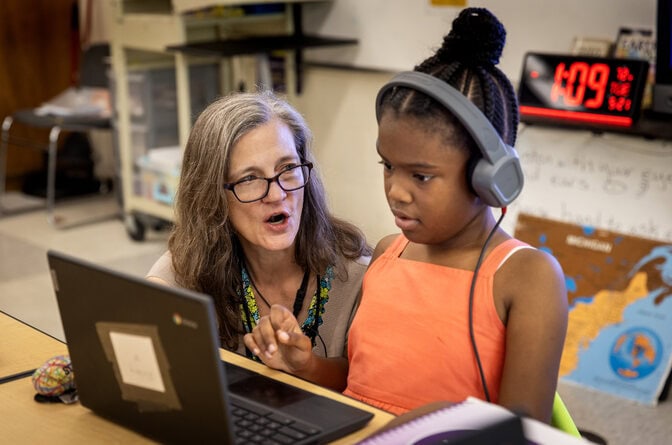
Computers have been a major component of classrooms in Trombley’s school district for the past 10 years. Although she and her colleagues had digital lessons that work well, they still had some pen-and-paper lessons without a digital counterpart. When the pandemic forced a quick transition to remote learning, some of the most interactive components of the in-person lessons didn’t translate well to a digital medium.
“I personally feel like I got away from my real ingenuity, and I’m trying to work my way back. I think many of my colleagues are feeling the same way,” Trombley said.
Research evaluating digital learning’s effectiveness is similarly mixed. Whether it improves learning comes down to whether it enables students to engage in active, project-based learning, according to a 2024 report by the European Commission’s Joint Research Centre. Soloway founded the Center for Digital Curriculum in 2019 with this sentiment in mind.
“COVID forced the switch to technology, and we’re not going back, but education hasn’t done a digital transformation—it’s done a digital transition,” said Soloway. “You can’t just digitize paper lessons and expect the students to be engaged without the project-based learning that a good teacher brings to an in-person classroom. Learning is in the conversation, the feedback, the engagement and in the back-and-forth discourse. Not just sitting there with a computer. The engaging lessons in Roadmaps keeps the students truly engaged.”
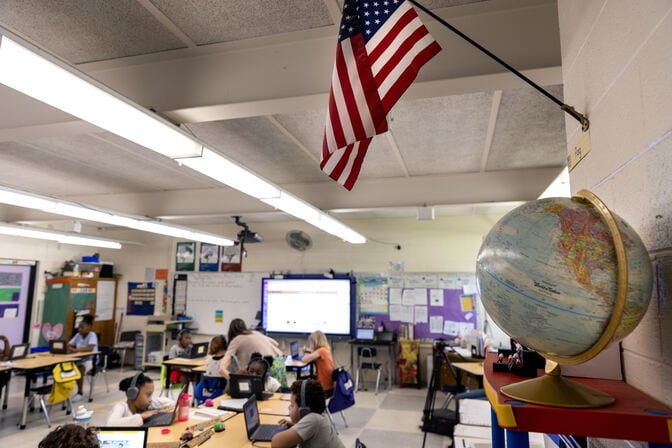
The students’ reactions to the variety of digital lessons Bruzzano used in her one-to-one computing classroom show how variable their effects can be. She drew from both the Roadmaps catalog and district-mandated lessons available through another educational software company. The district-mandated lessons often felt like a chore to the students, whose most common question about the task was “do I have to?”
Of the district-mandated lessons, one math lesson disguised as a video game was particularly unpopular. Students took on the role of an alien who has to navigate rock towers, jungles, and other exotic locations. When the alien came across an obstacle, the students had a few minutes to correctly answer a series of multiplication questions. Correct answers removed the barrier, allowing the alien to continue its journey. Wrong answers meant the students had to try again.
Despite looking like a game, the software didn’t spark joy like the interactive electricity labs. Many students were checked out. Riley watched equations cycle on and off the screen unanswered. Bruzzano said at times emotions would run higher.
“Sometimes my kids would get so upset because it goes too fast for them,” said Bruzzano. “They never had a sense of accomplishment. I had one girl that sometimes would get under the table because she was so upset. There was a way to slow it down, but I would have to go to each individual computer and fix it for them—every single day.”
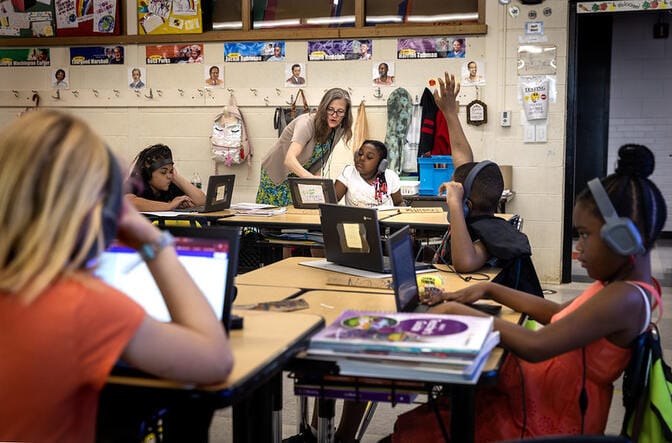
Roadmaps was less rigid and gave Bruzzano a variety of features that made the material more accessible to her students. For those who weren’t reading at grade level, she could record herself giving the directions, which the students could listen to by clicking a megaphone-shaped button next to the written directions. The Roadmaps platform also allows students to voice record their answers, a feature that a lot of her students took advantage of in a variety of subjects. In language arts class, students sounded out the syllables of vocab words into their computer mics: “A-dor-a-ble, adorable.”
These features are often necessary for students to engage with the lessons, Bruzzano said. That’s why she also made original lessons inside Roadmaps. Her personal collection of lessons grew over the time she used the platform, beginning in 2022. She could even share her content in a public catalog for other teachers to find and download for free.
“All the data says that literacy has been in decline over the last 10 years, and there’s a danger that we’re not educating our kids well enough anymore. We can’t teach the kids of today using yesterday’s methods. We need to be imaginative and transform the digital curricula into something that really takes advantage of what computers can do to help our children develop core literacy and numeracy skills,” Soloway said.
Current Roadmappers interested in trying the new EV lessons can access them in the Roadmap Collection. Teachers new to Roadmaps can enroll by contacting the Center for Digital Curriculum.
The Roadmap platform is licensed to a company called Roadmap Learning Inc. Soloway and the University of Michigan have financial interests in Roadmap Learning Inc.